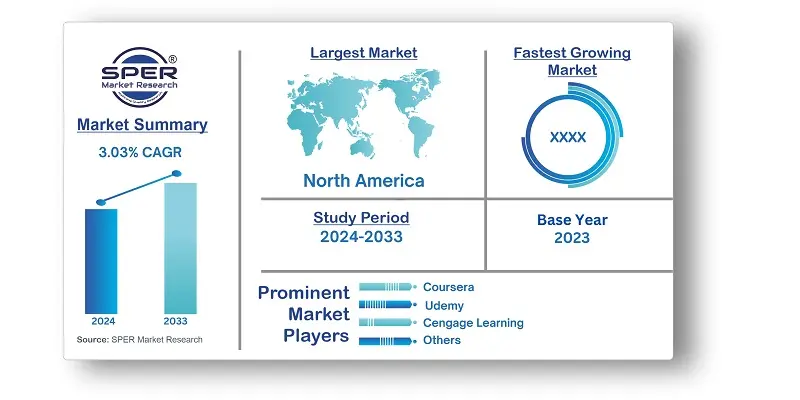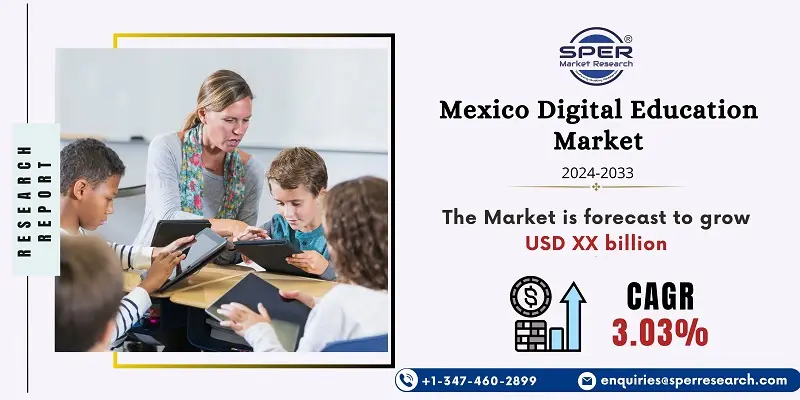
Mexico Digital Education Market Trends, Share, Size, Demand, Revenue and Future Outlook
Mexico Digital Education Market Growth, Size, Trends Analysis- By Learning Type, By Course Type- Regional Outlook, Competitive Strategies and Segment Forecast to 2033
| Published: Oct-2024 | Report ID: IACT24166 | Pages: 1 - 107 | Formats*: |
| Category : Information & Communications Technology | |||
- February 2023; In order to create its first Professional Certificate program, edX teamed up with AWS. In addition to helping students get ready for the AWS Certified Solutions Architect - Associate test, the Professional Certificate program in Cloud Solutions Architecture offers the information and abilities needed to begin a career in cloud architecture.
- May 2022; With the launch of its Clips platform, Coursera offers more than 10,000 short videos and lectures from prestigious universities and corporations. By the end of 2023, the firm hopes to have over 200,000 movies available. Employers can enable their staff to start learning new skills in less than ten minutes by providing them with Clips, which increases employee access to the most important and in-demand skill development content.


| Report Metric | Details |
| Market size available for years | 2020-2033 |
| Base year considered | 2023 |
| Forecast period | 2024-2033 |
| Segments covered | By Learning Type, By Course Type |
| Regions covered | Northern Mexico, Central Mexico, Southern Mexico and Others |
| Companies Covered | Academia en LÃnea, Cengage Learning, Coursera, Duolingo, EdX, Khan Academy, Plataforma Aprende, Platzi, SofÃa, and Udemy. |
- Higher Education Institutions
- K-12 Schools
- Corporate Training Providers
- EdTech Startups
- Government Educational Initiatives
- Non-Profit Organizations
- Students
- Parents
| By Learning Type: | |
| By Course Type: |
- Mexico Digital Education Market Size (FY’2024-FY’2033)
- Overview of Mexico Digital Education Market
- Segmentation of Mexico Digital Education Market By Learning Type (self-paced Online Education, Instructor-led Online Education and Others)
- Segmentation of Mexico Digital Education Market By Course Type (Science and Technology Courses, Entrepreneurship and Business Management Courses and Others)
- Statistical Snap of Mexico Digital Education Market
- Expansion Analysis of Mexico Digital Education Market
- Problems and Obstacles in Mexico Digital Education Market
- Competitive Landscape in the Mexico Digital Education Market
- Impact of COVID-19 and Demonetization on Mexico Digital Education Market
- Details on Current Investment in Mexico Digital Education Market
- Competitive Analysis of Mexico Digital Education Market
- Prominent Players in the Mexico Digital Education Market
- SWOT Analysis of Mexico Digital Education Market
- Mexico Digital Education Market Future Outlook and Projections (FY’2024-FY’2033)
- Recommendations from Analyst
1.1. Scope of the report1.2. Market segment analysis
2.1. Research data source2.1.1. Secondary Data2.1.2. Primary Data2.1.3. SPER’s internal database2.1.4. Premium insight from KOL’s2.2. Market size estimation2.2.1. Top-down and Bottom-up approach2.3. Data triangulation
4.1. Driver, Restraint, Opportunity and Challenges analysis4.1.1. Drivers4.1.2. Restraints4.1.3. Opportunities4.1.4. Challenges4.2. COVID-19 Impacts of the Mexico Digital Education Market.
5.1. SWOT Analysis5.1.1. Strengths5.1.2. Weaknesses5.1.3. Opportunities5.1.4. Threats5.2. PESTEL Analysis5.2.1. Political Landscape5.2.2. Economic Landscape5.2.3. Social Landscape5.2.4. Technological Landscape5.2.5. Environmental Landscape5.2.6. Legal Landscape5.3. PORTER’s Five Forces5.3.1. Bargaining power of suppliers5.3.2. Bargaining power of buyers5.3.3. Threat of Substitute5.3.4. Threat of new entrant5.3.5. Competitive rivalry5.4. Heat Map Analysis
6.1. Mexico Digital Education Market Manufacturing Base Distribution, Sales Area, Product Type6.2. Mergers & Acquisitions, Partnerships, Product Launch, and Collaboration in Mexico Digital Education Market
7.1. Mexico Digital Education Market Size, Share and Forecast, By Learning Type, 2020-20267.2. Mexico Digital Education Market Size, Share and Forecast, By Learning Type, 2027-20337.3. Self-paced Online Education7.4. Instructor-led Online Education7.5. Others
8.1. Mexico Digital Education Market Size, Share and Forecast, By Course Type, 2020-20268.2. Mexico Digital Education Market Size, Share and Forecast, By Course Type, 2027-20338.3. Science and Technology Courses8.4. Entrepreneurship and Business Management Courses8.5. Others
9.1. Mexico Digital Education Market Size and Market Share
10.1. Mexico Digital Education Market Size and Market Share By Region (2020-2026)10.2. Mexico Digital Education Market Size and Market Share By Region (2027-2033)10.3. Northern Mexico10.4. Central Mexico10.5. Southern Mexico10.6. Others
11.1. Academia en LÃnea11.1.1. Company details11.1.2. Financial outlook11.1.3. Product summary11.1.4. Recent developments11.2. Cengage Learning11.2.1. Company details11.2.2. Financial outlook11.2.3. Product summary11.2.4. Recent developments11.3. Coursera11.3.1. Company details11.3.2. Financial outlook11.3.3. Product summary11.3.4. Recent developments11.4. Duolingo11.4.1. Company details11.4.2. Financial outlook11.4.3. Product summary11.4.4. Recent developments11.5. EdX11.5.1. Company details11.5.2. Financial outlook11.5.3. Product summary11.5.4. Recent developments11.6. Khan Academy11.6.1. Company details11.6.2. Financial outlook11.6.3. Product summary11.6.4. Recent developments11.7. Plataforma Aprende11.7.1. Company details11.7.2. Financial outlook11.7.3. Product summary11.7.4. Recent developments11.8. Platzi11.8.1. Company details11.8.2. Financial outlook11.8.3. Product summary11.8.4. Recent developments11.9. Udemy11.9.1. Company details11.9.2. Financial outlook11.9.3. Product summary11.9.4. Recent developments11.10. Others
SPER Market Research’s methodology uses great emphasis on primary research to ensure that the market intelligence insights are up to date, reliable and accurate. Primary interviews are done with players involved in each phase of a supply chain to analyze the market forecasting. The secondary research method is used to help you fully understand how the future markets and the spending patterns look likes.
The report is based on in-depth qualitative and quantitative analysis of the Product Market. The quantitative analysis involves the application of various projection and sampling techniques. The qualitative analysis involves primary interviews, surveys, and vendor briefings. The data gathered as a result of these processes are validated through experts opinion. Our research methodology entails an ideal mixture of primary and secondary initiatives.



Frequently Asked Questions About This Report
PLACE AN ORDER
Year End Discount
Sample Report
Pre-Purchase Inquiry
NEED CUSTOMIZATION?
Request CustomizationCALL OR EMAIL US
100% Secure Payment






Related Reports
Our Global Clients
Our data-driven insights have influenced the strategy of 200+ reputed companies across the globe.




















